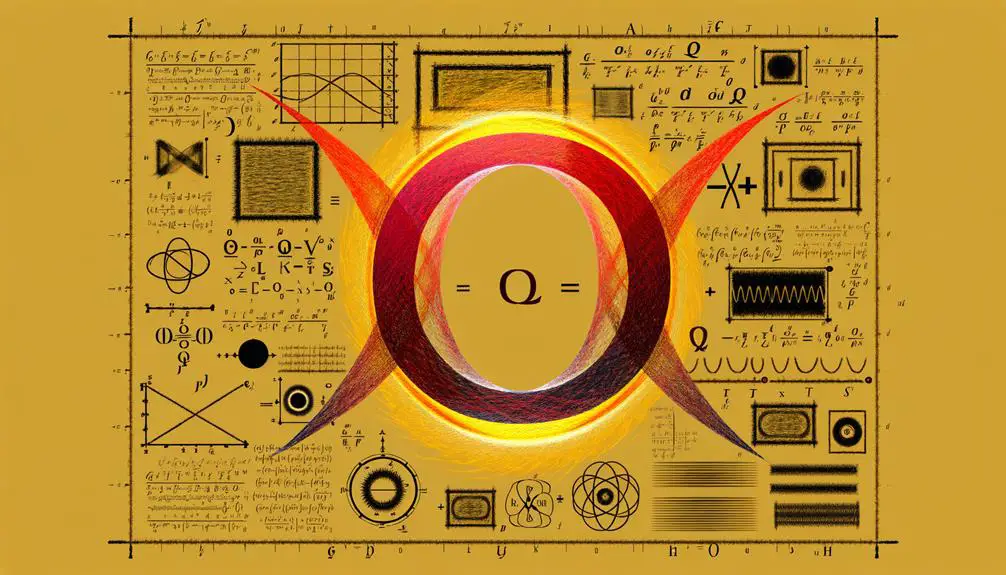What Are the Omega Symbol’s Different Meanings in Physics?
In physics, the Omega symbol (Ω) signifies various essential concepts. It primarily represents electrical resistance, quantifying the opposition to electric current flow, governed by Ohm's Law.
Additionally, omega (ω) denotes angular velocity, measuring rotational speed in radians per second, crucial for mechanical systems. In cosmology, it describes the cosmological density parameter, essential for understanding the universe's geometry and fate.
The symbol also appears in solid-state physics, representing parameters fundamental to material properties. Each application highlights Omega's diverse importance in scientific fields, offering a profound comprehension of physical phenomena upon further exploration.

Key Takeaways
- Omega (Ω) represents electrical resistance, quantifying opposition to electric current flow in circuits.
- Omega (ω) denotes angular velocity, measuring rotational speed in radians per second.
- In cosmology, Omega (Ω) is the cosmological density parameter, indicating the universe's density relative to critical density.
- Omega (ω) signifies angular frequency in wave phenomena, defining cycles per second.
- In quantum mechanics, Omega (Ω) is used for solid angles, crucial for understanding angular distributions.
Electrical Resistance (Ohm)

In the field of physics, the symbol Omega (Ω) is commonly used to represent electrical resistance, measured in ohms.
Electrical resistance fundamentally describes the opposition that a material presents to the flow of electric current. It is an important parameter in Ohm's Law, which states that resistance (R) is the ratio of voltage (V) across a conductor to the current (I) flowing through it, expressed as R = V/I.
Materials with high resistance impede current flow more than those with low resistance. The precise measurement and control of resistance are vital in designing electrical circuits and components, ensuring desired performance and safety.
Understanding resistance is essential for advancements in electronics, energy distribution, and various technological applications.
Angular Velocity
Angular velocity, represented by the Greek letter omega (ω), quantifies the rate at which an object rotates around a specific axis. Defined mathematically, it is the change in angular displacement per unit time, typically measured in radians per second.
This scalar quantity is essential in kinematics for describing rotational motion. The direction of ω follows the right-hand rule, aligning with the axis of rotation. The magnitude of angular velocity directly influences the kinetic energy of rotating bodies and is fundamental in dynamic systems analysis.
Understanding ω is vital for applications ranging from mechanical engineering to orbital mechanics, where precise rotational dynamics are essential for system stability and performance optimization.
Solid-State Physics

Solid-state physics explores the properties and behaviors of solid materials at the atomic and molecular levels, providing essential insights into their electrical, thermal, and mechanical characteristics. The omega symbol (Ω) is integral in representing various parameters in this field, such as electrical resistance and angular frequency. Understanding these properties requires a thorough analysis of crystal lattices, band structures, and electron mobility.
| Parameter | Symbol/Unit |
|---|---|
| Electrical Resistance | Ω (Ohm) |
| Angular Frequency | ω (rad/s) |
| Band Gap Energy | Eg (eV) |
Each parameter elucidates specific material attributes, interlinking fundamental physical laws with practical applications in semiconductors, superconductors, and insulators. The precision in characterizing these properties fosters advancements in technology, from microelectronics to quantum computing.
Cosmological Density Parameter
The omega symbol (Ω) extends its significance beyond solid-state physics to cosmology, where it denotes the cosmological density parameter. This parameter, often referred to as Ω, quantifies the ratio of the actual density of the universe to the critical density needed for a flat universe.
An Ω value of 1 indicates a flat universe, while values greater or less than 1 imply a closed or open universe, respectively. This parameter is essential for understanding the universe's fate, expansion, and geometry.
Other Uses in Physics

In various branches of physics, the omega symbol (Ω) frequently emerges as a pivotal notation for diverse physical quantities and concepts.
In electrical engineering and circuit theory, Ω denotes electrical resistance, measured in ohms.
In rotational dynamics, ω represents angular velocity, a vector quantity specifying the rate of rotation around an axis.
Additionally, in the study of wave phenomena, ω signifies angular frequency, correlating with the temporal frequency of oscillatory systems.
Furthermore, in quantum mechanics, Ω is used to denote solid angles, integral for understanding angular distributions in three-dimensional space.
This multifaceted symbol underscores the interconnectedness of physical principles, facilitating a unified language for describing a wide array of phenomena across different subfields of physics.
Conclusion
The omega symbol (Ω) holds diverse meanings in physics, representing electrical resistance, angular velocity, solid-state physics phenomena, and the cosmological density parameter.
Particularly, in electrical resistance, the omega symbol denotes the ohm, a unit named after Georg Simon Ohm. Intriguingly, Ohm's Law states that electrical resistance in a conductor is constant and independent of the current, a principle foundational to circuit theory.
The multifaceted applications of Ω illustrate its critical importance across various physics domains.






